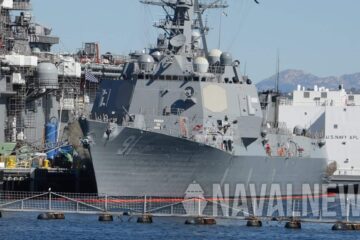From USS Gerald R. Ford Public Affairs
During Ford’s largest aircraft embark to date, CVW-8 completed critical milestones on the first-in-class ship, testing secure communications and tactical data links, supporting the use of Network Enabled Weapons (NEW), Combined fixed- and rotary-wing Close Air Support integration, and SIMDIS, a multi-dimensional interactive graphical and video display to playback large events for debriefs.
Underway, CVW-8 conducted day and night cyclic flight operations totaling 324 catapult launches and arrested landings, qualifying 50 pilots, including Ford’s Commanding Officer, Capt. J.J. Cummings. To date, Ford has conducted 3,480 catapult launches and arrested landings with EMALS and AAG. Additionally, during this execution of cyclic flight operations with CVW-8, Ford moved thousands of pounds of inert ordnance via Advanced Weapons Elevators to F/A-18 Super Hornets, employed during Close Air Support and air-to-ground training missions. Executing cyclic operations and arming aircraft with bombs from the ship’s magazines were firsts for the team.
The air wing’s embark provided the first opportunity for Ford’s weapons department to execute a full ordnance movement using a lower stage weapons elevator. Performing as advertised, Ford’s AWEs conducted more than 1,300 cycles during this latest at sea period that enabled the successful transfer of 176 inert bombs in support of air wing operations. Ford’s AWEs have conducted over 10,000 cycles to date.
Commander, Carrier Strike Group (CSG) 12 also embarked Ford during this underway, marking the first time a Strike Group Commander and staff embarked Ford for operations. CSG-12 was able to successfully conduct all intended command and control operations, control and distribute the link picture, and coordinate with Ford and Truman Strike Group assets as well as higher headquarters. Rear Admiral Craig Clapperton, commander, Carrier Strike Group (CSG) 12 assessed that the Strike Group and ship are ahead of schedule in this important command and control domain.

Clapperton emphasized that this PDT&T phase is all about operating Ford systems with Fleet operators and discovering anomalies and working solutions. These solutions will be key to ensuring that when Ford enters the Fleet after operational testing, the ship is ready to support the war fighter.
For example, on June 2, just prior to a scheduled flight deck operation cycle, the ship’s Electromagnetic Aircraft Launch System (EMALS) went down. Loss of EMALS curtailed flight operations to some extent, but the Strike Group, ship, and air wing team still accomplished significant goals scheduled for the Ford-class aircraft carrier.
After several days of troubleshooting and assessing a fault in the launch system’s power handling elements, embarked EMALS experts and Ford’s crew restored the system to enable the safe fly-off of the air wing on Sunday morning, June 7.
“The ship’s response to these EMALS challenges underscores our ability to identify and to correct issues impacting flight operations quickly. That’s the purpose of the PDT&T phase,”.
“The learning and improvement that results from pushing the systems will make the ship and air wing team better and more effective in future underway events.”
Rear Admiral Craig Clapperton, commander, Carrier Strike Group (CSG) 12.
Following the CVW-8’s fly-off on Sunday, Ford will return to port as planned and continue PDT&T scheduled events.
-End-






